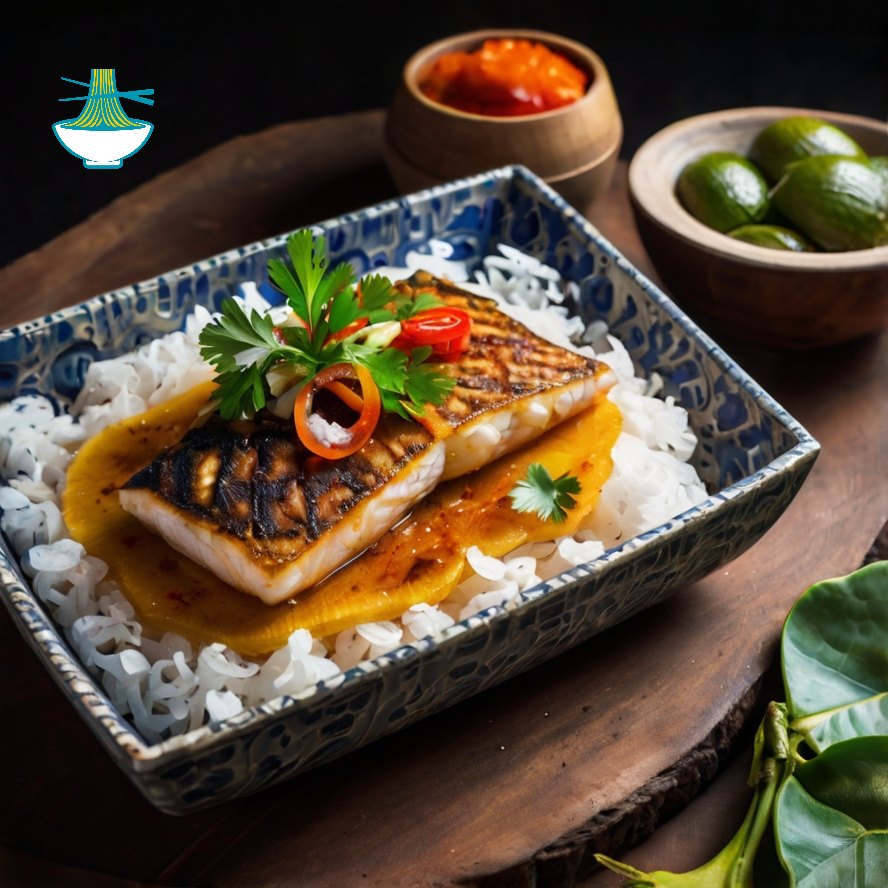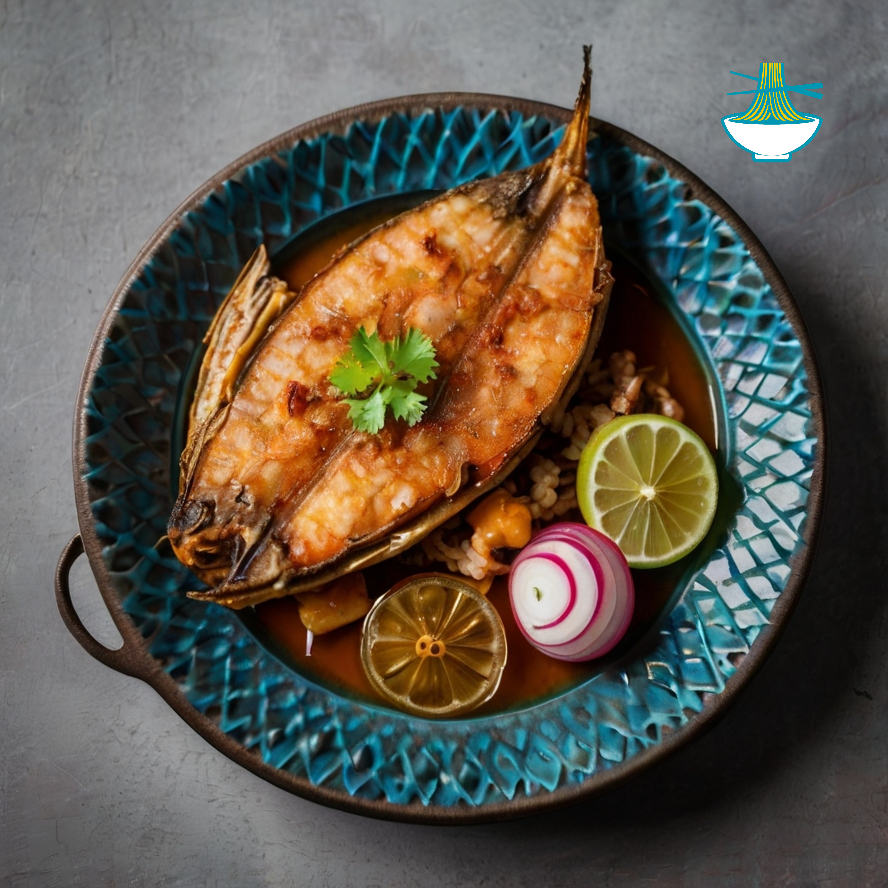Attieke, a traditional dish from West Africa, is made from fermented cassava, giving it a tangy flavor and fluffy texture. Rich in carbohydrates, it serves as an excellent energy source. When paired with grilled fish or meat, it creates a balanced meal packed with protein, vitamins, and minerals. While Attieke is naturally gluten-free, the fermentation process also promotes gut health by introducing beneficial probiotics. This dish is a staple in Liberian cuisine and is celebrated for its simplicity, versatility, and nutritional benefits.
Ingredients:
- 2 cups Attieke (fermented cassava couscous)
- 1 cup warm water
- 1 tablespoon vegetable oil
- Salt to taste
- Optional: Grilled fish, meat, or vegetables for serving
Alternatives for Ingredients:
- For those who prefer to make Attieke even healthier, you can substitute some ingredients. For example, using olive oil instead of vegetable oil can add healthy monounsaturated fats, which are beneficial for heart health. Additionally, homemade vegetable sauces made from tomatoes, onions, and garlic can be drizzled over Attieke for added flavor and nutritional value without the use of processed condiments.
Instructions:
1. Fluff the Attieke Gently
Start by placing the Attieke in a large bowl. Using a fork, fluff the Attieke to separate the grains. This technique prevents clumps from forming and ensures that each granule absorbs moisture evenly. Fluffing also enhances the texture, making it light and airy. Take your time with this step for the best results.
2. Add Warm Water Gradually
When hydrating the Attieke, always add warm water gradually. This gives you better control over the consistency of the dish. Stir gently after each addition, ensuring that the Attieke absorbs the water without becoming overly saturated. Aim for a texture that is soft yet slightly firm, avoiding mushiness. If needed, adjust the water to achieve the desired consistency.
3. Steam for Tenderness
Once the water has been absorbed, cover the bowl with a lid or a clean kitchen towel. Let the Attieke steam for 5 minutes. This step ensures the grains become tender and fully hydrated without losing their texture. For a more professional touch, you can use a steamer instead of simply covering the bowl, ensuring even steam distribution.
4. Drizzle and Season
After steaming, drizzle the Attieke with vegetable oil to add flavor and richness. Season with salt to taste, and be sure to mix it well. This is a crucial step for achieving a balanced, flavorful dish. If you want to elevate the flavor, consider using extra virgin olive oil or adding a pinch of black pepper or smoked paprika.
5. Serve with Protein
For a balanced and nutritious meal, serve the Attieke warm alongside grilled fish, meat, or vegetables. Choose protein sources that complement the mild flavor of Attieke. Fish like tilapia or mackerel work beautifully, but grilled chicken or roasted vegetables can also be a great match.
Pro Tip: Control the Texture
To ensure the Attieke is soft but not too soggy, avoid adding too much water at once. The key is to add a small amount of water, stir gently, and allow the Attieke to steam to soften naturally.
Serving Suggestions for Attieke:
- Attieke is a versatile dish and can be paired with a variety of foods to create a well-balanced meal. You can serve it with grilled vegetables like zucchini, eggplant, or tomatoes to enhance its flavor and nutrient content. For special occasions, consider presenting Attieke with grilled fish, chicken, or even a vegetable stir-fry to create a vibrant, colorful, and nutritious meal. Attieke also pairs well with salads, making it a great addition to light lunches or dinner parties.
Healthy Additions for Attieke:
- To further enhance the health benefits of Attieke, you can consider adding fresh vegetables or herbs. For example, parsley or cilantro can be mixed into Attieke to add fresh flavors and boost the nutritional value. These herbs contain antioxidants, vitamins, and minerals that support immune health and overall wellness. Additionally, adding bell peppers, tomatoes, or cucumbers to Attieke can contribute to fiber intake and improve digestion.
Storage Tips for Attieke:
- Proper storage is essential to maintain the taste and nutritional quality of Attieke. After preparing it, Attieke should be stored in an airtight container in the refrigerator for up to two days. This prevents it from drying out and preserves its texture. To avoid spoilage, make sure it is tightly wrapped to prevent exposure to air, which can lead to loss of flavor. You can also freeze Attieke for long-term storage; however, it may slightly change in texture upon thawing.
Additional Benefits of Attieke:
- Aside from its high carbohydrate content, Attieke provides other benefits that can support overall health. The fermentation process involved in making Attieke adds probiotics, which help improve gut health by promoting the growth of beneficial bacteria in the digestive system. This can lead to better digestion, enhanced immunity, and even improved skin health. Moreover, Attieke's complex carbohydrates provide a steady energy supply, making it an excellent choice for individuals needing sustained energy throughout the day.
Frequently Asked Questions (FAQs)
1. Can Attieke be made without oil for a healthier version?
Yes, Attieke can be made without oil if you're aiming for a lighter, healthier version. While oil adds richness and flavor, you can omit it or replace it with a splash of vegetable or chicken broth for added moisture. This keeps the dish flavorful without the extra fat. For even more flavor, consider adding freshly chopped herbs or a squeeze of lemon to brighten up the taste.
2. How can I prevent Attieke from becoming too dry after storing it?
To prevent Attieke from drying out, store it in an airtight container immediately after it cools to room temperature. If you notice it has dried out, rehydrate it by adding a small amount of warm water and steaming it again for a few minutes. A quick drizzle of olive oil or a splash of broth will also help restore its original texture and flavor.
3. Can I use Attieke as a substitute for rice or couscous in other recipes?
Yes! Attieke makes an excellent substitute for rice or couscous in a variety of dishes. Its fluffy texture and mild flavor complement a wide range of proteins, vegetables, and sauces. You can serve it as a base for stir-fries, curries, or stews, similar to how you would use rice or couscous, offering a gluten-free and slightly tangy alternative.
4. What can I pair with Attieke for a vegetarian or vegan meal?
Attieke pairs beautifully with a variety of vegetarian or vegan options. Try it with a vegetable stir-fry, roasted root vegetables, or a hearty bean stew. For added protein, pair it with tofu, tempeh, or lentils. The versatility of Attieke means it can complement a wide array of plant-based dishes, making it an ideal base for vegan meals.
5. Can Attieke be prepared in advance for meal prep?
Absolutely! Attieke is perfect for meal prepping. You can prepare a large batch and store it in the refrigerator for up to two days. When reheating, add a small amount of water to rehydrate the Attieke and prevent it from becoming too dry. For added convenience, pair it with proteins and veggies, and divide the portions into meal prep containers for easy, healthy meals throughout the week.

Nutritional values and benefits
1. 1 Cup Attieke (150g)
- Calories: 160
- Carbohydrates: 38g
- Protein: 1g
- Fat: 0g
- Fiber: 2g (8% DV)
Minerals:
- Calcium: 20mg (2% DV)
- Potassium: 300mg (8% DV)
- Nutritional Benefit: Attieke is a high-energy food made primarily of carbohydrates, making it an ideal choice for replenishing energy. Its fermentation process also adds probiotics, which support digestive health.
2. 1 Tablespoon Vegetable Oil (15g)
- Calories: 120
- Fat: 14g
- Saturated Fat: 2g
- Unsaturated Fat: 12g
- Nutritional Benefit: Vegetable oil provides essential healthy fats that support energy production and help absorb fat-soluble vitamins like A, D, E, and K.
3. Grilled Fish (1 Medium Fillet, 100g)
- Calories: 140
- Protein: 22g
- Fat: 5g
- Omega-3 Fatty Acids: 0.8g
Minerals:
- Calcium: 20mg (2% DV)
- Iron: 1mg (6% DV)
- Nutritional Benefit: Grilled fish is a lean protein source rich in omega-3 fatty acids, which support heart and brain health. It also provides essential minerals like iron and calcium for strong bones and healthy blood.
4. Grilled Meat (Optional, 100g)
- Calories: 250
- Protein: 26g
- Fat: 16g
- Saturated Fat: 6g
Minerals:
- Iron: 2mg (12% DV)
- Zinc: 4mg (27% DV)
- Nutritional Benefit: Grilled meat offers high-quality protein and iron, essential for muscle development and oxygen transport in the blood.
5. Salt (1 Teaspoon, 5g)
- Sodium: 2,300mg (96% DV)
- Nutritional Benefit: Salt enhances the flavor of the dish. Use in moderation to maintain healthy blood pressure.
Summary of Nutritional Benefits:
- Attieke is a versatile dish that provides sustained energy from its cassava base. When paired with grilled fish or meat, it becomes a nutritionally balanced meal offering protein, healthy fats, and essential vitamins and minerals. The fermentation of cassava promotes gut health, making Attieke a wholesome choice for a satisfying and nutritious meal.


Comments